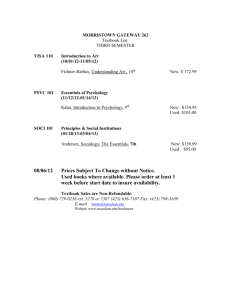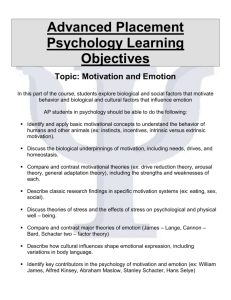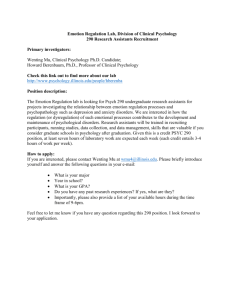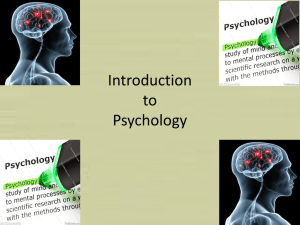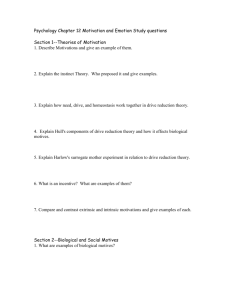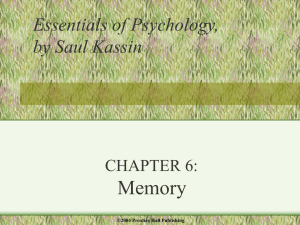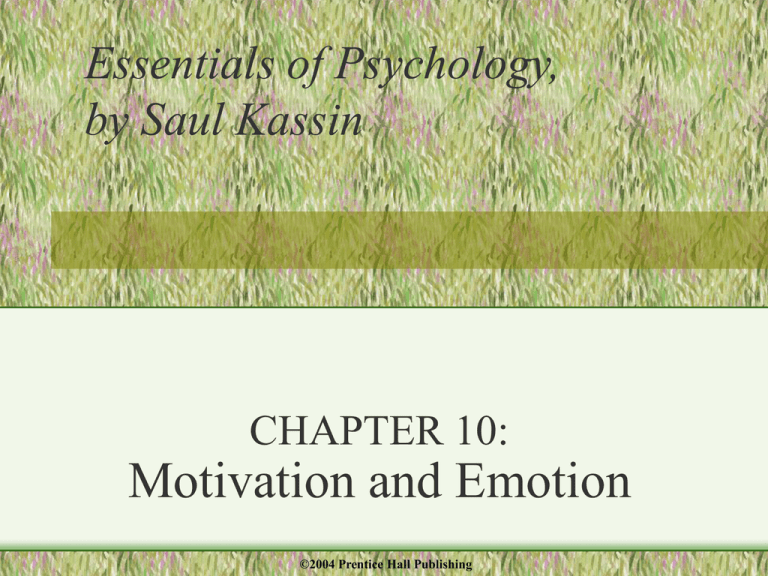
Essentials of Psychology,
by Saul Kassin
CHAPTER 10:
Motivation and Emotion
©2004 Prentice Hall Publishing
Motivation and Emotion
Motivation
What Motivates Us?
Basic Human Motives
Social Motives
Emotion
The Physiological Component
The Expressive Component
The Cognitive Componet
Human Emotion: Putting the Pieces Together
Kassin, Essentials of Psychology - ©2004 Prentice Hall Publishing
What Motivates Us?
General Theories of Motivation
• Drive Theory
– The notion that physiological needs arouse tension
that motivates action
• Arousal Theory
– The notion that motivation comes from a need to
achieve and maintain an optimum level of arousal
• Incentive Theory
– The notion that we behave in ways that produce a
valued inducement
Kassin, Essentials of Psychology - ©2004 Prentice Hall Publishing
What Motivates Us?
The Pyramid of Human Motivations
Maslow's Pyramid of Needs
• Heirarchy of Needs
– Maslow’s list of basic
needs that have to be
satisfied before
people can become
self-actualized
• Low-level needs must be
met before trying to
satisfy higher-level needs
• Self-actualization is to
fulfill one’s potential
Kassin, Essentials of Psychology - ©2004 Prentice Hall Publishing
Basic Human Motives
Hunger and Eating
Cannon and Washburn's Hunger Experiment
• Participants swallowed a
balloon to record stomach
contractions and pushed
button to report hunger
feelings.
• Hunger feelings came at
peak of contractions.
• This theory has been
discredited.
• Stomach contractions do not
cause hunger.
Kassin, Essentials of Psychology - ©2004 Prentice Hall Publishing
Basic Human Motives
Hunger and Eating
The Hunger-Regulation Cycle
• When blood glucose is low, people become hungry.
• Food raises glucose, reduces hunger and eating.
Kassin, Essentials of Psychology - ©2004 Prentice Hall Publishing
Basic Human Motives
Hunger and Eating
Obesity
– The state of having a
surplus of body fat that
causes a person to exceed
his or her optimum weight
by 20 percent
• According to U.S. health
trends, 1983-2002,
Americans are
increasingly overweight.
• However, Americans are
more health conscious in
other areas.
U.S. Health Trends, 1983-2002
Kassin, Essentials of Psychology - ©2004 Prentice Hall Publishing
Basic Human Motives
Hunger and Eating
Body Weights of Twins
• Identical twins are
more similar in body
weight than are
fraternal twins.
• Genetic factors play a
large role in body
weight.
Kassin, Essentials of Psychology - ©2004 Prentice Hall Publishing
Basic Human Motives
Hunger and Eating: Eating Disorders
• Anorexia Nervosa
– An eating disorder in which the person,
usually an adolescent girl or young woman,
limits her eating and becomes emaciated
• Bulimia Nervosa
– An eating disorder that is marked by cycles
of binge eating followed by purging
– This disorder is twice as common as anorexia
Kassin, Essentials of Psychology - ©2004 Prentice Hall Publishing
Basic Human Motives
Sexual Motivation
• Surveys of Sexual Practices
– Men and women respond differently to surveys about
their sexual motivations.
• Men report more sexual permissiveness and promiscuity
• The Evolution of Desire
– Evolutionary psychology offers an explanation for
gender differences in sexual motivation.
– Others adopt a more psychological versus biological
approach when explaining these differences.
– It is difficult to differentiate between the influences of
evolution and those of culture.
Kassin, Essentials of Psychology - ©2004 Prentice Hall Publishing
Social Motives
Belongingness Motives
• Need for Affiliation
– Desire to establish and maintain social
contacts
• Need for Intimacy
– Desire for close relationships characterized
by open and intimate communication
• Self-Disclosure
– Sharing of intimate details about oneself to
another person
Kassin, Essentials of Psychology - ©2004 Prentice Hall Publishing
Social Motives
Esteem Motives
• Achievement Motivation
– A strong desire to accomplish difficult tasks,
outperform others, and excel
– People who score high in the need for
achievement work harder and are more
persistent, innovative, and future-oriented.
– They also set challenging but realistic goals.
– And, they are more interested in mastering a
task than they are afraid of failing at it.
Kassin, Essentials of Psychology - ©2004 Prentice Hall Publishing
Emotion
The Physiological Component
The Expressive Component
The Cognitive Component
Human Emotion: Putting the Pieces Together
Kassin, Essentials of Psychology - ©2004 Prentice Hall Publishing
Emotion
Three Components of Emotion
Emotion
A feeling
state
characterized
by
physiological
arousal,
expressive
behaviors, and
a cognitive
interpretation.
Kassin, Essentials of Psychology - ©2004 Prentice Hall Publishing
The Physiological Component
A Historical Perspective
James-Lange Theory of Emotion
• Emotion arises from
physiological arousal
– Happiness comes from
smiling
– Sadness comes from
crying
Kassin, Essentials of Psychology - ©2004 Prentice Hall Publishing
The Physiological Component
A Historical Perspective
Cannon-Bard Theory of Emotion
• Emotion originates in
the thalamus
• “Body”
(physiological
systems) and “Mind”
(emotional
experience) are
independently
activated at the same
time.
Kassin, Essentials of Psychology - ©2004 Prentice Hall Publishing
The Physiological Component
Brain Centers of Emotion
• Limbic System
– This system, which includes the thalamus,
hypothalamus, hippocampus, and amygdala
regulates emotion.
• The amygdala is highly involved in fear
responses
• Cerebral Cortex
– No single region of the cortex regulates all
human emotions.
Kassin, Essentials of Psychology - ©2004 Prentice Hall Publishing
The Physiological Component
Generalized Autonomic Arousal
The Autonomic Nervous System
“Fight or
Flight”
Restore
Calm
Kassin, Essentials of Psychology - ©2004 Prentice Hall Publishing
The Expressive Component
Nonverbal Communication
How Well do People Identify Emotions?
Kassin, Essentials of Psychology - ©2004 Prentice Hall Publishing
The Expressive Component
Nonverbal Communication
The Facial Electromyograph EMG
– An electronic instrument
used by emotion researchers
to record activity in the
facial muscles
• Electrodes placed on the face
record activity in various muscles.
– Positive emotions increase activity in
cheeks.
– Negative emotions increase activity
in forehead and brow areas.
Kassin, Essentials of Psychology - ©2004 Prentice Hall Publishing
The Expressive Component
Sensory Feedback
• Facial-Feedback Hypothesis
– The hypothesis that changes in facial
expression can produce corresponding changes
in emotion
– Zajonc, et al. had subjects repeat vowel sounds.
– Making some sounds - “ah” and “e” - caused
smiling and elevated mood.
– Making other sounds - “u” and “ü” - caused
frowning and lowered mood.
Kassin, Essentials of Psychology - ©2004 Prentice Hall Publishing
The Cognitive Component
Schachter’s Two-Factor Theory of Emotion
• Physiological arousal
– Sweaty palms
– Increased heart rate
– Rapid breathing
• Cognitive Label
– Attribute source of arousal
to a cause.
• To have an emotion, both
factors are required.
Kassin, Essentials of Psychology - ©2004 Prentice Hall Publishing
The Cognitive Component
Counterfactual Thinking
– Imagining alternative scenarios and
outcomes that might have happened but
did not
– Wondering “What if…?”
– More likely in response to negative events
– More likely when one is close to the other
outcome (e.g., a lottery ticket with 4/5
winning numbers, a silver medalist, etc.)
Kassin, Essentials of Psychology - ©2004 Prentice Hall Publishing
The Cognitive Component
Is Cognition Necessary?
Pathway of Fear Without “Thought”
• Sensation of threat can
reach the amygdala via
direct path from thalamus
– The fast “low road”
• Sensation of threat also
travels from the thalamus
to the cortex
– The slow “high road”
• Cortical judgment can
override direct path
Kassin, Essentials of Psychology - ©2004 Prentice Hall Publishing
The Cognitive Component
Can People Predict Their Emotional States?
• Affective Forecasting
– The process by which people predict how
they would feel in the future, after various
positive and negative events
– People have difficulty predicting their emotions
in response to future events.
– People overestimate the duration of their
emotional reactions (durability bias).
Kassin, Essentials of Psychology - ©2004 Prentice Hall Publishing
Human Emotion:
Putting the Pieces Together
Russell's Circumplex Model
• Which emotions are
universal, felt in all cultures?
– Fear, anger, joy, disgust,
surprise, and sadness
• Russell identified two main
dimensions of emotion.
• Emotions can be sorted
according to these
dimensions in several
cultures.
Kassin, Essentials of Psychology - ©2004 Prentice Hall Publishing
Human Emotion:
Putting the Pieces Together
• Are There Cultural Differences in Emotion?
– Some aspects of emotion seem universal.
– However, cultures affect the categorization of
emotions and the display rules that govern when
and where emotions can be expressed.
Kassin, Essentials of Psychology - ©2004 Prentice Hall Publishing
Human Emotion:
Putting the Pieces Together
• Pleasure and the Pursuit of Happiness
– Three predictive indicators of happiness are:
• Social relationships
• Employment
• Physical health
Kassin, Essentials of Psychology - ©2004 Prentice Hall Publishing
Human Emotion:
Putting the Pieces Together
National Wealth and Subjective Well-Being
• Over a 40-year period, Americans became over twice as
wealthy, but no happier.
Kassin, Essentials of Psychology - ©2004 Prentice Hall Publishing
Human Emotion:
Putting the Pieces Together
• Pleasure and the Pursuit of Happiness
– Does Money Buy Happiness?
• After basic needs are met, increased wealth does not
result in a significant rise in levels of happiness.
• One explanation is that people have a set baseline
level of happiness toward which they gravitate.
– Identical twins are more similar in levels of happiness
compared to fraternal twins.
– Happiness levels seem to be relatively stable over time
and situations.
Kassin, Essentials of Psychology - ©2004 Prentice Hall Publishing


